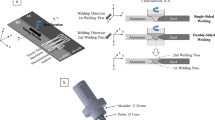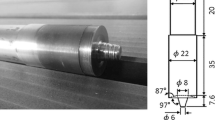Abstract
This study focuses on the influence of the welding parameters on defectiveness, thermal field and grain size in friction stir welding of aluminium alloy 7075-T6. Different welded specimens were produced employing various rotational speeds and welding speeds. In the first part of the analysis, the quality of the joints was evaluated by microscopic observation of the jointed cross-sections to investigate the modification of the shape of the stirred zones and the occurrence of internal voids. Afterwards, temperature and grain size of welds obtained at welding speed of 60 mm/min have been measured to study the influence of the rotational speed on the heat input. Temperature measurements have been carried out with thermocouples and infrared camera. Grain size evolution of the material was analysed by optical observations of the jointed cross-sections and the average grain size in the nugget zone (NZ) has been estimated through electron backscatter diffraction. The results globally show that the first internal defects arose at the same time as an unexpected zone on the advancing side between the shoulder affected zone (SAZ) and NZ. In sound welds, from 800 to 1400 rpm, the peak temperature showed an increase between 5 and 15%, depending on the considered zone, while the grain size in the stirred zone increased from 2 to 3.6 μ m. Overall, it has been shown that the approach to the defective condition is due to the low heat input which is responsible for improper material flow during the process.


















Similar content being viewed by others
References
Thomas WM, Nicholas ED, Needham JC, Murch MG, Templesmith P, Dawes CJ (1995) U.S. Patent No. 5,460,317, October 24
Mishra R, Komarasamy M (2016) Friction stir welding of high strength 7XXX aluminum alloys. Butterworth-Heinemann, Denton
Ericsson M, Sandström R. (2003) Influence of welding speed on the fatigue of friction stir welds, and comparison with MIG and TIG. Int J Fatigue 25(12):1379–1387
Yan Z, Liu X, Fang H (2017) Mechanical properties of friction stir welding and metal inert gas welding of Al-Zn aluminum alloy joints. Int J Adv Manuf Technol 91(9-12):3025–3031
Sato YS, Kokawa H, Enomoto M, Jogan S (1999) Microstructural evolution of 6063 aluminum during friction-stir welding. Metall Mater Trans A Phys Metal Mater Sci 30(9):2429–2437
Cavaliere P, Squillace A, Panella F (2008) Effect of welding parameters on mechanical and microstructural properties of AA6082 joints produced by friction stir welding. J Mater Process Technol 200(1–3):364–372
Fuller CB, Mahoney M, Calabrese M, Micona L (2010) Evolution of microstructure and mechanical properties in naturally aged 7050 and 7075 Al friction stir welds. Mater Sci Eng A 527(9):2233–2240
Imam M, Biswas K, Racherla V (2013) On use of weld zone temperatures for online monitoring of weld quality in friction stir welding of naturally aged aluminium alloys. Mater Des 52:730–739
Long T, Tang W, Reynolds AP (2007) Process response parameter relationships in aluminium alloy friction stir welds, 12:(4):311–317
Cui S, Chen ZW, Robson JD (2010) A model relating tool torque and its associated power and specific energy to rotation and forward speeds during friction stir welding/processing. Int J Mach Tools Manuf 50(12):1023–1030
Su H, Wu CS, Pittner A, Rethmeier M (2013) Simultaneous measurement of tool torque, traverse force and axial force in friction stir welding. J Manuf Process 15(4):495–500
Astarita A, Squillace A, Carrino L (2014) Experimental study of the forces acting on the tool in the friction-stir welding of AA 2024 T3 sheets. J Mater Eng Perform 23(10):3754–3761
Kim YG, Fujii H, Tsumura T, Komazaki T, Nakata K (2006) Three defect types in friction stir welding of aluminum die casting alloy. Mater Sci Eng A 415(1–2):250–254
Chen H. B. i. n., Yan K, Lin T, Chen S. B. e. n., Jiang CY, Zhao Y (2006) The investigation of typical welding defects for 5456 aluminum alloy friction stir welds. Mater Sci Eng A 433(1–2):64–69
Khan NZ, Siddiquee AN, Khan ZA, Shihab SK (2015) Investigations on tunneling and kissing bond defects in FSW joints for dissimilar aluminum alloys. J Alloys Compd 648:360–367
Rajakumar S, Muralidharan C, Balasubramanian V (2011) Influence of friction stir welding process and tool parameters on strength properties of AA7075-T6 aluminium alloy joints. Mater Des 32(2):535–549
Zhang H, Lin SB, Wu L, Feng JC, Ma SL (2006) Defects formation procedure and mathematic model for defect free friction stir welding of magnesium alloy. Mater Des 27(9):805–809
Ramulu PJ, Narayanan RG, Kailas SV, Reddy J (2013) Internal defect and process parameter analysis during friction stir welding of Al 6061 sheets. Int J Adv Manuf Technol 65(9–12):1515–1528
Rasti J (2018) Study of the welding parameters effect on the tunnel void area during friction stir welding of 1060 aluminum alloy. Int J Adv Manuf Technol 97(5–8):2221–2230
Zeng XH, Xue P, Wang D, Ni DR, Xiao BL, Wang KS, Ma ZY (2018) Material flow and void defect formation in friction stir welding of aluminium alloys. Sci Technol Weld Join 23(8):677–686
Su JQ, Nelson TW, Mishra R, Mahoney M (2003) Microstructural investigation of friction stir welded 7050-T651 aluminium. Acta Mater 51(3):713–729
Imam M, Racherla V, Biswas K, Fujii H, Chintapenta V, Sun Y, Morisada Y (2017) Microstructure-property relation and evolution in friction stir welding of naturally aged 6063 aluminium alloy. Int J Adv Manuf Technol 91(5–8):1753–1769
Chao YJ, Qi X, Tang W (2003) Heat transfer in friction stir welding - experimental and numerical studies. J Manuf Sci Eng Trans ASME 125(1):138–145
Song M, Kovacevic R (2003) Thermal modeling of friction stir welding in a moving coordinate system and its validation. Int J Mach Tools Manuf 43(6):605–615
Nandan R, Roy GG, Debroy T (2006) Numerical simulation of three dimensional heat transfer and plastic flow during friction stir welding. Metall Mater Trans A Phys Metall Mater Sci 37(4):1247–1259
Masaki K, Sato YS, Maeda M, Kokawa H (2008) Experimental simulation of recrystallized microstructure in friction stir welded Al alloy using a plane-strain compression test. Scr Mater 58(5):355–360
Morisada Y, Imaizumi T, Fujii H (2015) Clarification of material flow and defect formation during friction stir welding. Sci Technol Weld Join 20(2):130–137
Yi D, Onuma T, Mironov S, Sato YS, Kokawa H (2017) Evaluation of heat input during friction stir welding of aluminium alloys. Sci Technol Weld Join 22(1):41–46
Peel MJ, Steuwer A, Withers PJ, Dickerson T, Shi Q, Shercliff H (2006) Dissimilar friction stir welds in AA5083-AA6082. Part I: process parameter effects on thermal history and weld properties. Metall Mater Trans A Phys Metall Mater Sci 37(7):2183–2193
Fehrenbacher A, Duffie NA, Ferrier NJ, Pfefferkorn FE, Zinn MR (2014) Effects of tool-workpiece interface temperature on weld quality and quality improvements through temperature control in friction stir welding. Int J Adv Manuf Technol 71(1–4):165–179
Silva ACF, De Backer J, Bolmsjö G (2017) Temperature measurements during friction stir welding. Int J Adv Manuf Technol 88(9–12):2899–2908
Sorger G, Sarikka T, Vilaça P, Santos TG (2018) Effect of processing temperatures on the properties of a high-strength steel welded by FSW. Weld World 62:1173–1185
Mahoney M, Rhodes CG, Flintoff JGP, Spurling RA, Bingel WH (1998) Properties of friction-stir-welded 7075 t651 aluminum. Metall Mater Trans A Phys Metall Mater Sci 29(7):1955–1964
Hwang Y, Kang Z, Chiou Y, Hsu H (2008) Experimental study on temperature distributions within the workpiece during friction stir welding of aluminum alloys. 48:778–787
Upadhyay P, Reynolds AP (2010) Effects of thermal boundary conditions in friction stir welded AA7050-T7 sheets. Mater Sci Eng A 527(6):1537–1543
Kadian AK, Puri G, Biswas P, Prediction of Thermal History of Friction Stir Welding by Considering Combined Stick and Slip Condition of AA1100 (Aimtdr) 1–7 (2014)
Al-Badour F, Merah N, Shuaib A, Bazoune A (2013) Coupled Eulerian Lagrangian finite element modeling of friction stir welding processes. J Mater Process Technol 213(8):1433– 1439
Lambiase F, Paoletti A, Di Ilio A (2018) Forces and temperature variation during friction stir welding of aluminum alloy AA6082-T6. Int J Adv Manuf Technol 337–346
Pew JW, Nelson TW, Sorensen CD (2007) Torque based weld power model for friction stir welding. Sci Technol Weld Join 12(4):341–347
Fratini L, Buffa G, Palmeri D, et al. (2006) Material flow in FSW of AA7075-T6 butt joints: Numerical simulations and experimental verifications. Sci Technol Weld Join 11(4):412–421
Acknowledgements
The authors want to thank Metallicadour for the production of the joints and Jérémy BEGA (Arts et Métiers ParisTech) and I2M for the help during the metallographic preparation and etching of the samples.
Funding
This project received funding from the European Union’s Marie Skłodowska–Curie Actions (MSCA) Innovative Training Networks (ITN) H2020-MSCA-ITN-2017 under the grant agreement N°764979.
Author information
Authors and Affiliations
Corresponding author
Additional information
Publisher’s note
Springer Nature remains neutral with regard to jurisdictional claims in published maps and institutional affiliations.
Rights and permissions
About this article
Cite this article
Ambrosio, D., Wagner, V., Garnier, C. et al. Influence of welding parameters on the microstructure, thermal fields and defect formation in AA7075-T6 friction stir welds. Weld World 64, 773–784 (2020). https://doi.org/10.1007/s40194-020-00869-4
Received:
Accepted:
Published:
Issue Date:
DOI: https://doi.org/10.1007/s40194-020-00869-4




